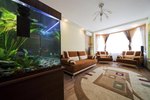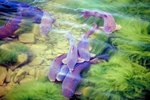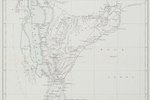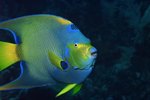Dramatic coloring make freshwater cichlids a low-maintenance and low-cost alternative to keeping a marine tank. Electric blue cichlids add eye-catching appeal to a tank, but you'll find more than one variety sold under this moniker. Striping, coloration of females and body shape are all clues to whether you have an electric blue hap or electric blue Johanni. Special care for each species includes regular water changes and a strict feeding schedule.
Electric Blue Hap
Other Names
The electric blue hap (Sciaenochromis fryeri) is the fish most commonly sold as an electric blue cichlid. This fish is sometimes labeled as an iceberg hap or hap ahli.
Description
The male electric blue hap sports intense blue coloring broken up by nine to 12 vertical bars on a stocky, elongated body. Females are silver or light blue and are smaller in size than the 6-inch males. Both males and females have orange, red or yellow markings on the anal fin.
Habitat
In the wild, the electric blue hap lives in the open waters of Lake Malawi where rocks meet sand. The fish enjoys having caves to hide in and rock crevices to forage in. Use sand or coral mix as substrate to help maintain a high pH at 7.7 to 8.6. The electric blue's aquarium should be at least 4 feet long and at least 55 gallons. The electric blue does best when the temperature is between 73 to 82 degrees and water hardness is between 5 to 10 dGH.
Tank Mates
While not as aggressive as some species of cichlid, the electric blue hap will eat smaller fish. Best tank mates include other cichlid haplochromis species. If you're keeping more than one electric blue hap, keep no more than one male in the tank with four or more females. Should you choose to keep your blue hap in a tank of his own, don't try adding other fish later -- he'll defend his territory against all intruders, even if they are larger than him.
Care and Feeding
The electric blue hap's tolerance for varied water conditions makes the fish a good choice for the novice cichlid owner. Water changes of 10 percent to 20 percent weekly keep the cichlid's water conditions optimal.
Electric blue haps are piscivores who will readily eat feeder fish placed in the tank. The can eat cichlid flakes and pellets as well as shrimp or worms. Feed them small meals several times per day to prevent overeating.
Electric Blue Johanni
Other Names
Electric Blue Johannis are also sold as Blue Mbunas, Bluegray Mbunas, Johanni Cichlids and Blue Johannis.
Description
The blue Johanni has a round snout and a torpedo-shaped body that grows to 4 inches. The Johanni's dorsal fin runs along the top of the entire back. Males are vibrant blue with bands of lighter blue running horizontally along the body; sometimes they're flanked by spots that cause a checkerboard effect. The males' fin edging is dark blue to black and tipped in light blue. Females and juvenile fish are yellowish-orange with an indistinct horizontal band that run from just behind their eyes to their tail. With proper care, a blue Johanni can live up to 12 years in the home aquarium.
Habitat
Blue Johannis prefer hard, alkaline water with pH of 7.7 to 8.6 and water hardness of 6 dGH. Keep the temperature between 73 and 82 degrees Fahrenheit, and provide a moderate amount of water movement with filtration. The fish is best kept by intermediate to advanced aquarists, as the species requires 20 percent to 50 percent water changes weekly to maintain water quality. The fish hails from rocky areas in Lake Malawi, so decorating with rocks and caves is essential for success.
Tank Mates
Blue Johannis are among the least aggressive of the melanochromis species and can co-exist with other African cichlids. If you're keeping the fish in a tank with other members of his own species, a male and several females can cohabit in a 30- to 40-gallon tank that is a minimum of 3 feet long to provide adequate swimming space. When combining the fish in a tank with other African cichlids, us a tank that is 100 gallons or larger.
Feeding Time
Blue Johannis thrive on several small feedings per day rather than one large one. Feed them cichlid pellets or flakes supplemented with fresh foods. The omnivorous fish can enjoy worms, shrimp, veggies and small fish as an addition to the primary diet.
Electric Blue Cousins
Other blue cichlids include the electric blue Jack Dempsey, a natural color variation of Nandopsis octofasciatum. Cichlids having similar coloration to the electric blue include the maingano cichlid and the haplochromis jacksoni ahli.
Writer Bio
Indulging her passion for vacation vagary through the written word on a full-time basis since 2010, travel funster Jodi Thornton-O'Connell guides readers to the unexpected, quirky, and awe-inspiring.





